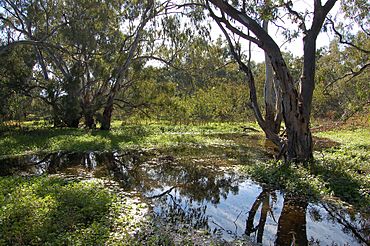Macquarie Marshes Nature Reserve facts for kids
Quick facts for kids Macquarie Marshes Nature ReserveNew South Wales |
|
|---|---|
|
IUCN Category Ia (Strict Nature Reserve)
|
|

An image of a healthy marsh in Macquarie Marshes Nature Reserve, taken in 2010
|
|
| Nearest town or city | Dubbo |
| Established | January 1971 |
| Area | 198.24 km2 (76.5 sq mi) |
| Website | Macquarie Marshes Nature Reserve |
| Footnotes | |
| Official name: Macquarie Marshes | |
| Designated: | 1 August 1986 |
| Reference #: | 337 |
| See also | Protected areas of New South Wales |
The Macquarie Marshes Nature Reserve is a special protected area of wetlands in New South Wales, Australia. Wetlands are areas where land is covered by water, either all the time or just for certain seasons. This reserve is found along the lower Macquarie River in northwestern New South Wales.
It covers about 19,824 hectares (48,990 acres), which is like 19,824 football fields! The reserve is located about 600 kilometres (370 mi) northwest of Sydney. It's also about 100 kilometres (62 mi) north of a town called Warren.
The Macquarie Marshes Nature Reserve is the most important part of the larger Macquarie Marshes. This area gets flooded often and has examples of all the different types of natural homes (habitats) found in the Marshes. There are also other important wetland areas outside the reserve, including large forests of river red gum trees and big nesting sites for birds.
Why the Marshes are Special
The Macquarie Marshes are formed when the flat lands along the river get flooded. This happens often, but not always at the same times. The nature reserve itself covers almost 20,000 hectares (49,000 acres). This is about 10% of the entire Macquarie Marshes floodplain, which is the flat land next to the river that gets flooded.
The reserve has two main parts: the North Marsh and the South Marsh. There's also a third, smaller reserve. In 1986, the North and South Marsh Nature Reserves were recognized as wetlands of international importance. This happened under an agreement called the Ramsar Convention, which helps protect important wetlands around the world.
The Macquarie Marshes are also listed on other important registers. These include the Register of the National Estate and the Register of the National Trust of Australia. They are also in the Directory of Important Wetlands in Australia. All these listings show how important these wetlands are for nature.
The reserve is also part of the Macquarie Marshes Important Bird Area. This means BirdLife International has identified it as a very important place for waterbirds to breed and raise their young.
Plants and Animals of the Marshes
The wetlands are home to many different types of plants. What grows where depends on how often and for how long the area is flooded. The most common plants are river red gum trees and large areas of common reeds.
These different plant areas create homes for many kinds of animals. The wetlands are especially important for waterbirds. Scientists have found:
- 211 different types of birds
- 8 types of native mammals
- 15 types of frogs
- 56 types of reptiles
- 24 types of native fish
The Macquarie Marshes are one of the most important places in Australia for two specific birds to breed: the intermediate egret and the straw-necked ibis.
Some birds in the marshes are considered vulnerable or threatened. This means their numbers are getting low, and they need protection. These birds include:
- Magpie goose
- Blue-billed duck
- Freckled duck
- Australasian bittern
- Brolga
- Painted snipe
- Osprey
- Glossy black cockatoo
- Turquoise parrot
- Square-tailed kite
- Major Mitchell's cockatoo
Challenges for the Marshes
The nature reserve protects only a small part of the entire marsh area. Much of the rest of the marshland is private land used for farming. Farmers use this land to graze cattle and sheep, and to grow crops.
The biggest challenge for the marshes is water. The plants and animals in the marshes need regular flooding to survive. However, more and more water is being taken from the Macquarie River upstream from the marshes. This water is used for irrigation, which means watering crops. When too much water is taken, there isn't enough left to flood the marshes as often or as much as needed.
To help protect the marshes, an environmental trust has been set up. This trust aims to get support from many people in the community to help save this important natural area.



